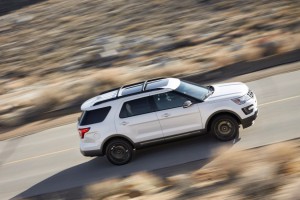Wondering what might be dragging down the mileage on your sporty new SUV or crossover? Look no further than your roof. According to a new study, roof racks may cost drivers as much as 25% more in gas usage.
Researchers in the first-of-its-kind study discovered that in in 2015, these popular add-ons were accounting for nearly 1% of all light-duty vehicle gasoline consumption. On the surface, it may not sound like much, but it equates to more than 100 million gallons of gas annually.
“I’ve always been intrigued by energy consumption that was somehow overlooked or ignored because, for example, it wasn’t in the test procedure,” said Alan Meier, who co-authored the study with Yuche Chen of the National Renewable Energy Laboratory. “In this case the fuel consumption of vehicles with after-market accessories isn’t captured in the test procedure.”
Use of roof racks requires vehicles to expend more energy due to aerodynamic drag. While there have been studies of their impact on individual vehicles — depending on the configuration, the fuel consumption penalty can be 0 to 25% on passenger cars — this is the first study to estimate impacts at the national level.
(FCA reportedly talking autonomous car deal with Google. For more, Click Here.)
The problem is only worsening due to several factors. First and foremost, the number of crossovers and SUVs – the vehicles mostly likely to sport the racks – sold in the U.S. has been on the rise for some time and as long as fuel prices remain low that trend seems unlikely to change.
Americans are also driving more. Motorists set a new record for February looing 232.2 billion miles, which was up 5.6% compared with year-ago figures, according to the U.S. Dept. of Transportation.
U.S. drivers drove more than ever last year, clocking a record 3.148 trillion miles behind the wheel, according to the Federal Highway Administration. It marked the second consecutive year the number has risen.
However, the biggest problem is the growing popularity of the racks. The survey estimates that the number of racks used on vehicles will rise 200% by 2040. Improving fuel economy of new vehicle will not be enough to offset the increased gasoline usage, they note.
(Carmakers, tech companies form alliance to promote autonomous driving. Click Here for more.)
“For comparison, the additional fuel consumption caused by roof racks is about six times larger than anticipated fuel savings from fuel cell vehicles and 40 percent of anticipated fuel savings from battery electric vehicles in 2040,” the study notes.
It’s not all doom and gloom. There are possible solutions to mitigate the impact of roof racks, most of which center on usage and design.
Manufacturers can produce roof racks with greatly improved aerodynamics. A policy to require energy labeling of roof racks could spur greater changes, the researchers note.
(Friends and foes speak out at autonomous hearing. Click Here for that report.)
Even greater energy savings would come from removing roof racks when not in use. Meier notes that they could be designed so as to be easier to remove. The researchers estimated that a government policy to minimize unloaded roof racks in combination with more energy-efficient designs would result in cumulative savings of the equivalent of 1.2 billion gallons of gasoline over the next 26 years.


This is a known fact about roof racks for years. This is old news. Also Fitting roof bars on SUV’s is often a styling fetish for some owners and manufacturers.
Here we are with all these energy efficiency developments for power trains and lightweight construction yet in Europe people are buying ‘taller and wider’ vehicles with the relative aerodynamics of a house brick – and those vehicle buyers probably stillexpress concern for the Polar bears. Am I being cynical?